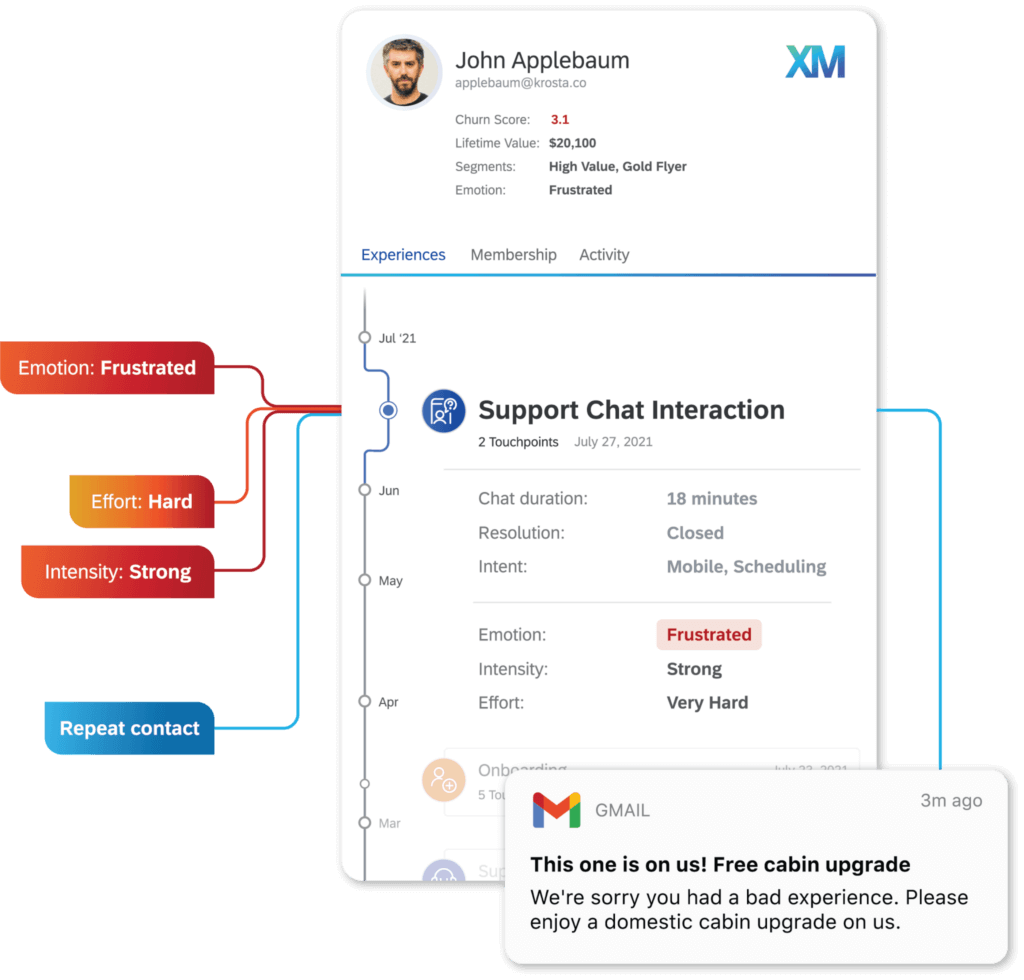What is Natural Language Generation?
Natural Language Generation, otherwise known as NLG, is a software process driven by artificial intelligence that produces natural written or spoken language from structured and unstructured data. It helps computers to feed back to users in human language that they can comprehend, rather than in a way a computer might.
For example, NLG can be used after analysing customer input (such as commands to voice assistants, queries to chatbots, calls to help centres or feedback on survey forms) to respond in a personalised, easily-understood way. This makes human-seeming responses from voice assistants and chatbots possible.
It can also be used for transforming numerical data input and other complex data into reports that we can easily understand. For example, NLG might be used to generate financial reports or weather updates automatically.
Understand your customers better with Qualtrics Discover and Natural Language Generation
How does it work?
Natural Language Generation technology is enabled through a range of computer science processes. These include:
Computational linguistics
The scientific understanding of written and spoken language from the perspective of computer-based analysis. This involves breaking down written or spoken dialogue and creating a system of understanding that computer software can use. It uses semantic and grammatical frameworks to help create a language model system that computers can utilise to accurately analyse our speech.
Natural Language Processing (NLP)
Natural Language Processing (NLP) is the actual application of computational linguistics to written or spoken human language. NLG is classified as a sub-category of Natural Language Processing.
Natural Language Understanding (NLU)
Natural Language Understanding (NLU) tries to determine not just the words or phrases being said, but the emotion, intent, effort or goal behind the speaker’s communication. It takes the understanding a step further and makes the analysis more akin to a human’s understanding of what is being said. Natural Language Understanding takes machine learning to a deeper level to help make comprehension even more detailed.
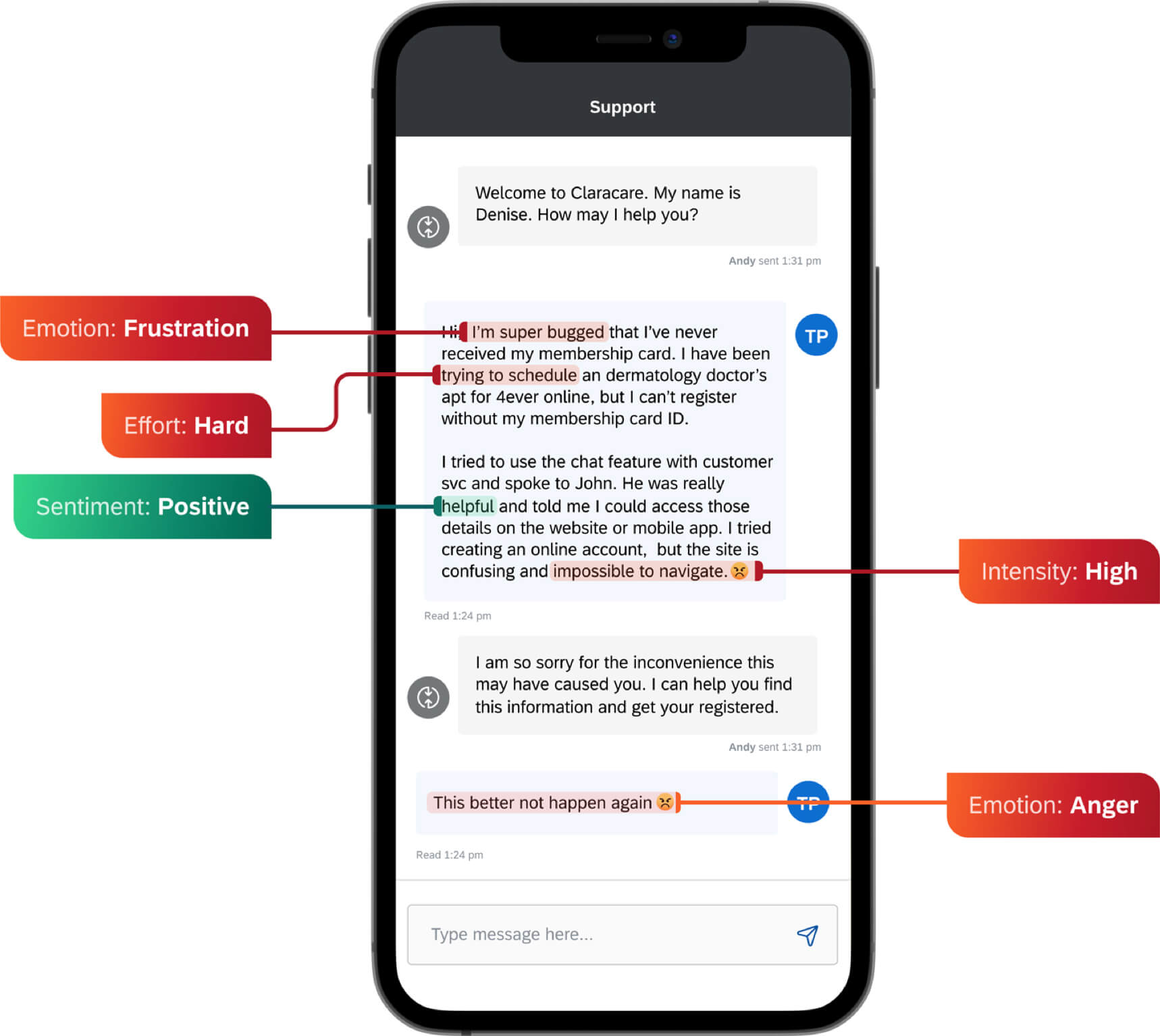
Why is Natural Language Generation important for business?
NLG techniques are already used in a wide variety of business tools, and are likely experienced on a day-to-day basis. You might see it at work in daily sports reporting in the news, or when using the voice search option on search engines.
Here are a few reasons why you should consider using Natural Language Generation technology in your business:
It can speed up your analysis of important data
Rather than analysing critical business information manually or by examining complex underlying data, you can use NLG software to quickly scan large quantities of input and generate reports.
For example, rather than studying masses of structured data found in business databases, you can set your NLG tool to create a narrative structure in language that your team can easily understand. You can also make it easier for your users to ask your software questions in terms they use normally, and get a quick response that is simple to comprehend.
This can save you time and money, as well as the resources needed to analyse data.
It can quickly respond to input on your behalf
Depending on your business, you might generate thousands of text or speech-based outputs that could be generated automatically using Natural Language Generation (NLG). Content creation examples might include:
- Product descriptions
- Sales reports
- Customer emails
- Automatic responses to surveys
- Chatbot or voice assistant replies
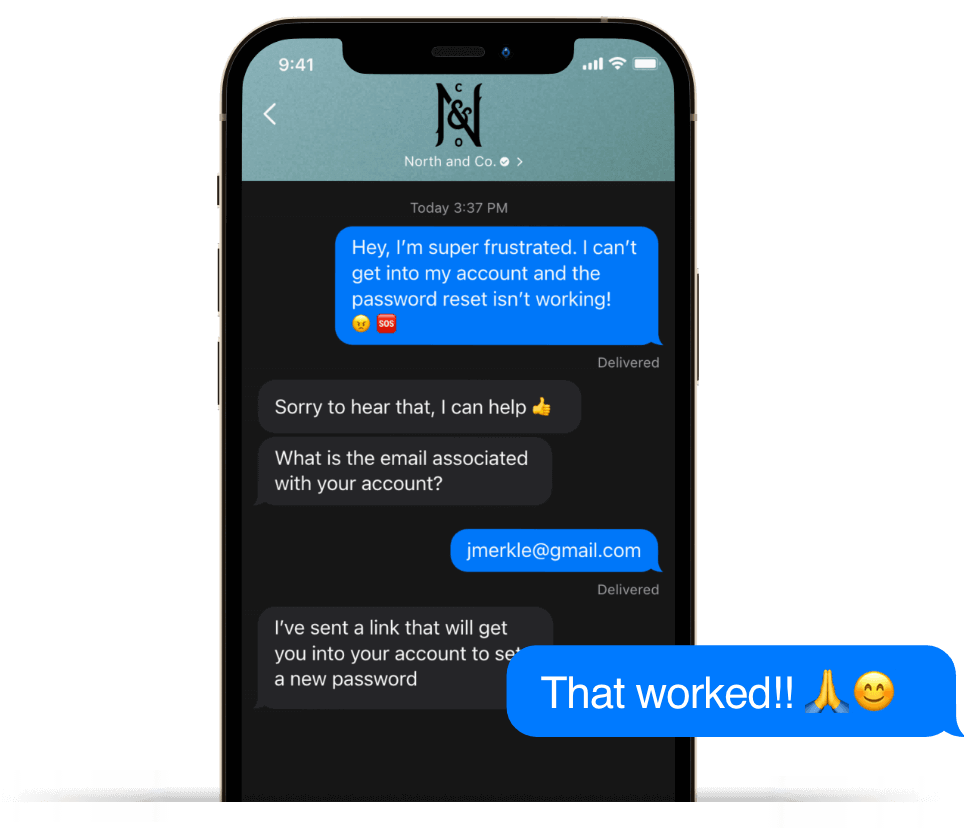
By using NLG, you’re able to take on the onerous task of creating these individually. This cuts down on the time and effort required by your team to manually respond to queries, reducing your cost to serve.
It can help you improve your customer relationships
With Natural Language Generation, you can summarise millions of customer interactions, tailored to specific use cases. Better still, you can respond in a more human-like way that is specifically in response to what’s being said.
We’ve found that two-thirds of consumers believe that companies need to be better at listening to feedback – and that more than 60% say businesses need to care more about them. By using NLG techniques to create personalised responses to what customers are saying to you, you’re able to strengthen your customer relationships at scale.
Understand the ROI of customer experience
What does using Natural Language Generation entail?
There are a few different ways in which Natural Language Generation can work, but the most common methods are called extractive and abstractive.
An extractive approach takes a large body of text, pulls out sentences that are most representative of key points, and combines them in a grammatically accurate way to generate a summary of the larger text.
An abstractive approach creates novel text by identifying key concepts and then generating new language that attempts to capture the key points of a larger body of text intelligibly.
Whichever approach is used, Natural Language Generation involves multiple steps to understand human language, analyse for insights and generate responsive text.
Natural Language Generation in six steps
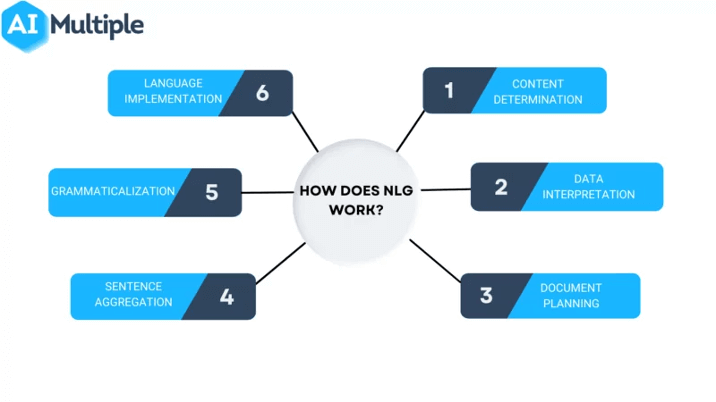
Data analysis
First, data (both structured data like financial information and unstructured data like transcribed call audio) must be analysed. The data is filtered, to make sure that the end text that is generated is relevant to the user’s needs, whether it’s to answer a query or generate a specific report. At this stage, your NLG tools will pick out the main topics in your source data and the relationships between each topic.
Data understanding
Here is where Natural Language processing, machine learning and a language model come in. Your software identifies the patterns in the data and based on its algorithmic training, it’s able to interpret what is being said and the context of these statements. For numerical data or other types of non-textual data, your software spots the data it’s been taught to recognise and is able to understand how it relates to actual text.
Document creation and structuring
At this stage, your NLG solutions are working to create data-driven narratives based on the data being analysed and the result you’ve requested (report, chat response etc.). A subsequent document plan is created.
Sentence aggregation
Sentences and parts of sentences that have been identified as relevant are put together to summarise the information to be presented.
Grammatical structuring
Your software begins its generated text, using natural language grammatical rules to make the text fit our understanding.
Language presentation
Finally, the software will create the final output in whatever format the user has chosen. As mentioned, this could be in the form of a report, a customer-directed email or a voice assistant response.
Natural Language Generation best practice
Natural Language Generation systems can be used to generate text across all kinds of business applications. However, as with any system, it’s best to use it in a targeted way to ensure you’re increasing your efficiency and generating ROI.
Use artificial intelligence to your advantage for responding to customers
Your customers are constantly giving you feedback. Whether it’s in surveys, third party reviews, social media comments or other forums, the people you interact with want to form a connection with your business.
By using NLG techniques to respond quickly and intelligently to your customers, you reduce the time they spend waiting for a response, reduce your cost to serve and help them to feel more connected and heard. Don’t leave them waiting, and don’t miss out on the masses of customer data available for insights.
Choose a highly intelligent system to transform your business internally
Relying on all your teams in all your departments to analyse every bit of data you gather is not only time-consuming, it’s inefficient. Take the burden off of your employees and start automatically generating key insights with NLG tools that create reports and respond to customer input with automatic reports and responses. With an integrated system, you’re able to keep multiple teams on top of the latest in-depth insights and automatically start responsive actions.
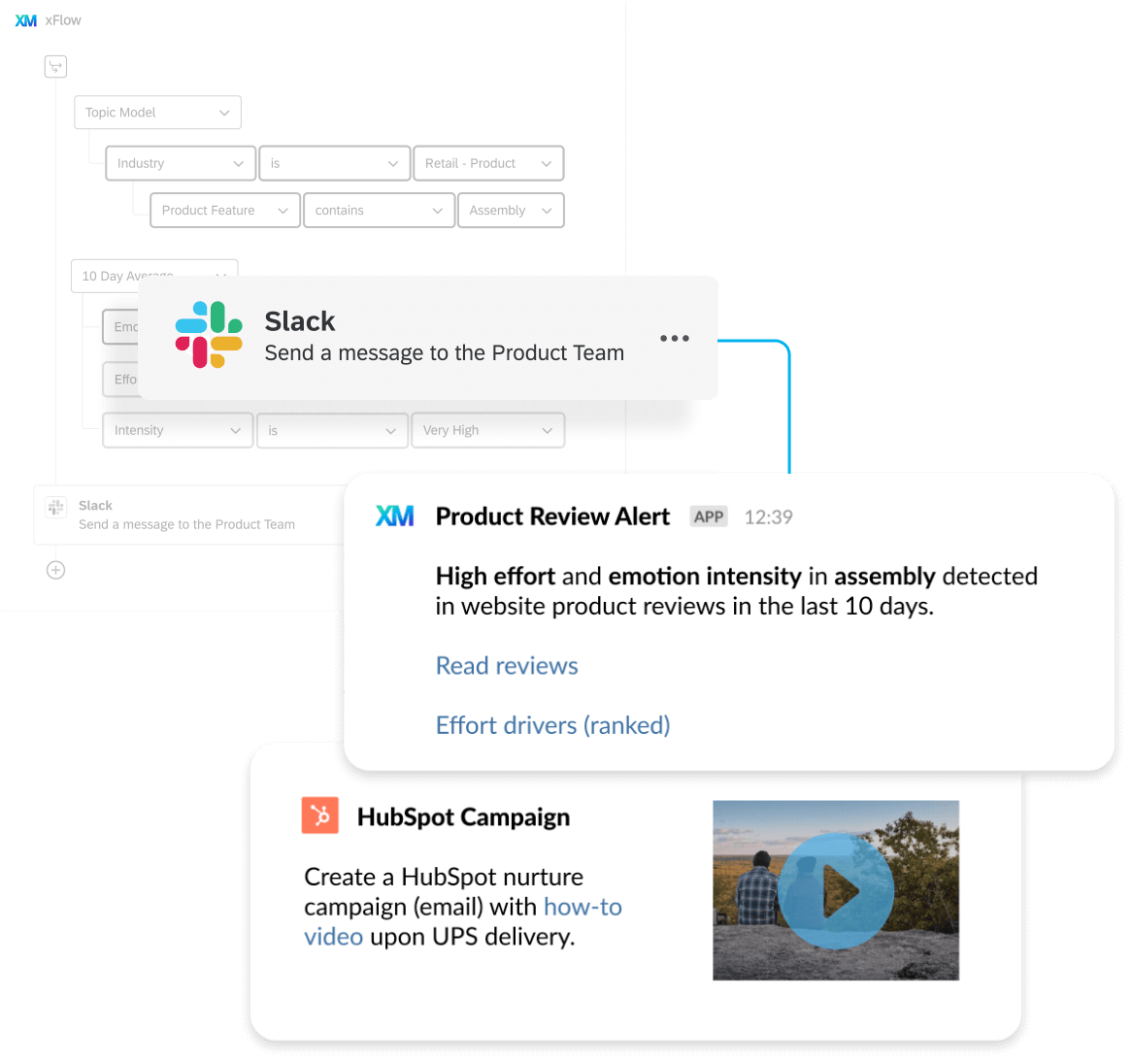
How to start using Natural Language Generation (NLG) Systems
Unstructured data can pose many challenges for Natural Language Generation (NLG) because it can be more difficult for a machine to determine the most meaningful information from large bodies of text.
At Qualtrics, we take a more prescriptive and hands-on approach in order to accomplish more human-like and meaningful storytelling around unstructured data.
By blending extractive and abstractive methods into a hybrid based approach, Qualtrics Discover delivers an ideal balance of relevancy and interpretability which are tailored to your business needs. This can be used to transform your contact center responses, summarise insights, improve employee performance, and more.
Learn more about Qualtrics Discover Solution
